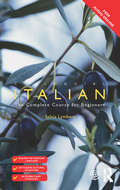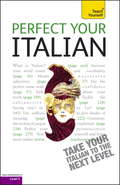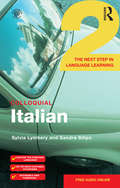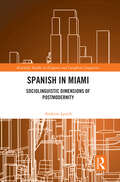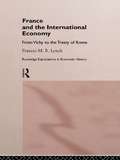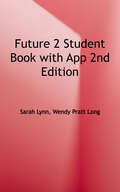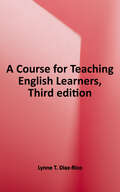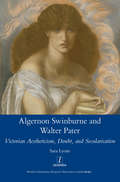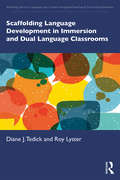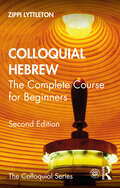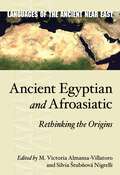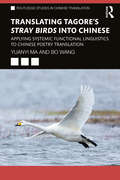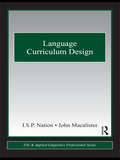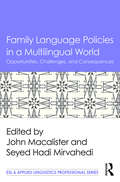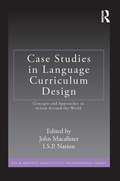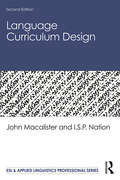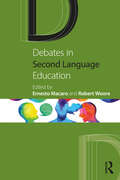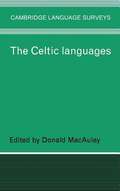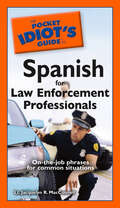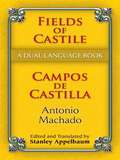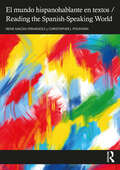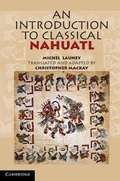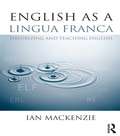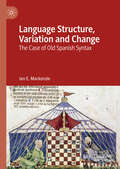- Table View
- List View
Colloquial Italian: The Complete Course for Beginners (Colloquial Ser. #Vol. 1)
by Sylvia LymberyColloquial Italian: The Complete Course for Beginners has been carefully developed by an experienced teacher to provide a step-by-step course to Italian as it is written and spoken today. Combining a clear, practical and accessible style with a methodical and thorough treatment of the language, it equips learners with the essential skills needed to communicate confidently and effectively in Italian in a broad range of situations. No prior knowledge of the language is required. Colloquial Italian is exceptional; each unit presents a wealth of grammatical points that are reinforced with a wide range of exercises for regular practice. A full answer key, a grammar summary, bilingual glossaries and English translations of dialogues can be found at the back as well as useful vocabulary lists throughout. Key features include: A clear, user-friendly format designed to help learners progressively build up their speaking, listening, reading and writing skills Jargon-free, succinct and clearly structured explanations of grammar An extensive range of focused and dynamic supportive exercises Realistic and entertaining dialogues covering a broad variety of narrative situations Helpful cultural points An overview of the sounds of Italian Balanced, comprehensive and rewarding, Colloquial Italian is an indispensable resource both for independent learners and students taking courses in Italian. Audio material to accompany the course is available to download free in MP3 format from www.routledge.com/cw/colloquials. Recorded by native speakers, the audio material features the dialogues and texts from the book and will help develop your listening and pronunciation skills.
Perfect Your Italian 2E: Teach Yourself
by Sylvia LymberyAre you looking for an improver's course in Italian which will make you sound like a native? If you already know some Italian and want to take it further, Perfect your Italian will guarantee success! Taking you from a good GCSE level (level B2 of the Common European Framework), this course teaches you advanced structures and vocabulary so that by the end of the course you will be at GCE Advanced Level, CEF level C1: Can express him/herself fluently and spontaneously without much obvious searching for expressions. Can use language flexibly and effectively for social, academic and professional purposes.Full of authentic texts and dialogues about complex subjects, this course covers a wide range of topics of the sort you will want to talk about when in Italy and teaches you the kind of everyday language and features of speech that will enable you to communicate with confidence and feel comfortable taking part in conversation with native speakers of Italy. The choice of material aims to give you something of the flavour of Italy today and each unit is based around a single theme with lively interviews and conversations on the accompanying recording. There are activities based on the interviews and texts to help you remember what you've learnt and put your knowledge into practice. The units are divided into sessions - to help you organize your learning time and break up the material into manageable chunks - and there are reminders throughout to refresh your memory of points you have learnt.Now fully updated to make your language learning experience fun and interactive. You can still rely on the benefits of a top language teacher and our years of teaching experience, but now with added learning features within the course and online.Learn effortlessly with new, easy-to-read page design and interactive features:/p>NOT GOT MUCH TIME?One, five and ten-minute introductions to key principles to get you started.AUTHOR INSIGHTSLots of instant help with common problems and quick tips for success, based on the author's many years of experience.GRAMMAR TIPSEasy-to-follow building blocks to give you a clear understanding.USEFUL VOCABULARYEasy to find and learn, to build a solid foundation for speaking.DIALOGUESRead and listen to everyday dialogues to help you speak and understand fast.TEST YOURSELFTests in the book and online to keep track of your progress.EXTEND YOUR KNOWLEDGEExtra online articles at: www.teachyourself.com to give you a richer understanding of the culture and history of Italy.TRY THISInnovative exercises illustrate what you've learnt and how to use it.
Colloquial Italian 2: The Next Step in Language Learning (The\colloquial 2 Ser.)
by Sylvia Lymbery Sandra SilipoDo you know Italian already and want to go a stage further? If you're planning a visit to Italy, need to brush up your Italian for work, or are simply doing a course, Colloquial Italian 2 is the ideal way to refresh your knowledge of the language and to extend your skills. Colloquial Italian 2 is designed to help those involved in self-study; structured to give you the opportunity to listen to and read lots of modern, everyday Italian, it has also been developed to work systematically on reinforcing and extending your grasp of Italian grammar and vocabulary. Key features of Colloquial Italian 2 include: Revision material to help consolidate and build up your basics A wided range of contemporary authentic documents, both written and audio Lots of spoken and written exercises in each unit Highlighted key structures and phrases, a Grammar reference and detailed answer keys A broad range of situations, focusing on day to day life in Italy. Audio material to accompany the course is available to download free in MP3 format from www.routledge.com/cw/colloquials. Recorded by native speakers, the audio material features the dialogues and texts from the book and will help develop your listening and pronunciation skills.
Spanish in Miami: Sociolinguistic Dimensions of Postmodernity (Routledge Studies in Hispanic and Lusophone Linguistics)
by Andrew LynchSpanish in Miami reveals the multifaceted ways in which the language is ideologically rescaled and sociolinguistically reconfigured in this global city. This book approaches Miami’s sociolinguistic situation from language ideological and critical cultural perspectives, combining extensive survey data with two decades of observations, interviews, and conversations with Spanish speakers from all sectors of the city. Tracing the advent of postmodernity in sociolinguistic terms, separate chapters analyze the changing ideological representation of Spanish in mass media during the late 20th century, its paradoxical (dis)continuity in the city’s social life, the political and economic dimensions of the Miami/Havana divide, the boundaries of language through the perceptual lens of Anglicisms, and the potential of South Florida—as part of the Caribbean—to inform our understanding of the highly complex present and future of Spanish in the United States. Spanish in Miami will be of interest to advanced students and researchers of Spanish, Sociolinguistics, and Latino Studies.
France and the International Economy: From Vichy to the Treaty of Rome (Routledge Explorations in Economic History)
by Frances LynchThis is a comprehensive history of a critically formative period in French economic history. Frances Lynch covers topics such as the post-war negotiations for American aid, the reconstruction of a capital market, the modernization of French agriculture, the liberalization of trade in the 1950s and subsequent economic growth.
Future 2 Student Book With App
by Sarah LynnSince it was first published, Future has helped over half a million students learn English and achieve their personal, career, and educational goals. Now in its second edition, this effective six-level program continues to address the diverse needs of adult learners, equipping them with transferrable academic, workplace, and English communication skills. Future, Second Edition supports the Workforce Innovation and Opportunity Act (WIOA) goals and helps students develop the skills outlined in the College and Career Readiness Standards and the English Language Proficiency Standards. New to this edition - Updated content exposes students to language and concepts used in workplace, school, and community settings. - More workplace vocabulary and skills, and functional language prepare learners for career success. - New content-rich readings with level-appropriate text complexity build content knowledge, introduce academic vocabulary, and require learners to analyze text and cite evidence to extend their learning. - New writing lessons focus on analyzing models, brainstorming, organizing ideas, and synthesizing unit learning into well-organized writing outcomes. - New Soft Skills at Work lessons help learners develop essential social and cultural skills, critical to career advancement and success. - Increased rigor built into all lessons at every level challenges learners to analyze, evaluate, predict, infer, and problem-solve. - Enhanced unit goals and lesson objectives ensure learners track and reflect on their own progress. Other highlights - Latest digital tools help develop students’ digital skills. - Research-based teaching strategies provide creative solutions for all stages of lesson planning and implementation. - Comprehensive digital and print resources for teachers enhance classroom instruction and simplify lesson planning. - Correlations to standards guide and support teachers in aligning their instruction with current standards. - Mapped to the Global Scale of English.
A Course for Teaching English Learners
by Lynne T. Diaz-RicoPrinciples and classroom techniques for teaching English language learners A Course for Teaching English Learners combines the fundamental principles of education with practical English language education techniques to help both pre- and in-service educators reach English language students in impactful ways. <p><p>The text provides background in cultural, linguistic, and sociocultural context, building a comprehensive framework for effective English language education. Uniquely, the text outlines both psychological and sociocultural contexts at play at all school levels, including second-language acquisition hurdles and strategies for teaching content subjects. <p><p>The 3rd Edition has been updated with a wealth of new and revised content, including new information on evolving certification requirements, modern demographic data, technology-enhanced language learning, translanguaging, and more.
Algernon Swinburne and Walter Pater: Victorian Aestheticism, Doubt and Secularisation
by SarahGlendon LyonsHow did literary aestheticism emerge in Victorian Britain, with its competing models of religious doubt and visions of secularisation? For Lyons, the aestheticism developed and progressively revised by Algernon Charles Swinburne (1837-1909) and Walter Pater (1839-1894) illuminates the contradictory impulses of modern secularism: on the one hand, a desire to cast itself as a form of neutrality or disinterestedness; on the other, a desire to affirm 'this world' as the place of human flourishing or even enchantment. The standard narrative of a 'crisis of faith' does not do justice to the fissured, uncertain quality of Victorian visions of secularisation. Precisely because it had the status of a confusing hypothesis rather than a self-evident reality, it provoked not only dread and melancholia, but also forms of fantasy. Within this context Lyons gives a fundamentally new account of the aims and nature of Victorian aestheticism, taking as a focus its deceptively simple claim that art is for art's sake first of all.
Scaffolding Language Development in Immersion and Dual Language Classrooms (Routledge Series in Language and Content Integrated Teaching & Plurilingual Education)
by Roy Lyster Diane J. TedickThis book introduces research-based pedagogical practices for supporting and enhancing language development and use in school-based immersion and dual language programs in which a second, foreign, heritage, or indigenous language is used as the medium of subject-matter instruction. Using counterbalanced instruction as the volume’s pedagogical framework, the authors map out the specific pedagogical skill set and knowledge base that teachers in immersion and dual language classrooms need so their students can engage with content taught through an additional language while continuing to improve their proficiency in that language. To illustrate key concepts and effective practices, the authors draw on classroom-based research and include teacher-created examples of classroom application. The following topics are covered in detail: defining characteristics of immersion and dual language programs and features of well-implemented programs strategies to promote language and content integration in curricular planning as well as classroom instruction and performance assessment an instructional model to counterbalance form-focused and content-based instruction scaffolding strategies that support students’ comprehension and production while ensuring continued language development an approach to creating cross-linguistic connections through biliteracy instruction a self-assessment tool for teachers to reflect on their pedagogical growth Also applicable to content and language integrated learning and other forms of content-based language teaching, this comprehensive volume includes graphics to facilitate navigation and provides Resources for Readers and Application Activities at the end of each chapter. The book will be a key resource for preservice and in-service teachers, administrators, and teacher educators.
Colloquial Hebrew: The Complete Course for Beginners
by Zippi LyttletonColloquial Hebrew provides a step-by-step course in Hebrew as it is written and spoken today. Combining a user-friendly approach with a thorough treatment of the language, it equips learners with the essential skills needed to communicate confidently and effectively in Hebrew in a broad range of situations. No prior knowledge of the language is required. Balanced, comprehensive and rewarding, this fully revised new edition of Colloquial Hebrew is an indispensable resource for both independent learners and students taking courses in Hebrew. This edition features an engaging story line throughout the book, encouraging the student to form dialogues and develop conversational skills. Key features include: • progressive coverage of speaking, listening, reading and writing skills • realistic and entertaining dialogues covering a broad variety of scenarios • translations and transliteration provided throughout in the key • structured, jargon-free explanations of grammar • an extensive, varied range of focused and stimulating exercises • useful vocabulary lists throughout the text • additional resources available at the back of the book and on the web, including a full answer key, a grammar summary, a list of verbs used in the book, a prepositions chart and glossaries Audio material to accompany the course is available to download free in MP3 format from www.routledge.com/cw/colloquials. Recorded by native speakers, the audio material features the dialogues and exercises from the book and will help develop your listening and pronunciation skills.
Ancient Egyptian and Afroasiatic: Rethinking the Origins (Languages of the Ancient Near East)
by M. Victoria Almansa-Villatoro and Silvia ŠtubŇovÁ NigrelliBy challenging assumptions regarding the proximity between Egyptian and Semitic Languages, Ancient Egyptian and Afroasiatic provides a fresh approach to the relationships and similarities between Ancient Egyptian, Semitic, and Afroasiatic languages. This in-depth analysis includes a re-examination of the methodologies deployed in historical linguistics and comparative grammar, a morphological study of Ancient Egyptian, and critical comparisons between Ancient Egyptian and Semitic, as well as careful considerations of environmental factors and archaeological evidence. These contributions offer a reassessment of the Afroasiatic phylum, which is based on the relations between Ancient Egyptian and the other Afroasiatic branches. This volume illustrates the advantages of viewing Ancient Egyptian in its African context.In addition to the editors, the contributors to this collection include Shiferaw Assefa, Michael Avina, Vit Bubenik, Leo Depuydt, Christopher Ehret, Zygmunt Frajzyngier, J. Lafayette Gaston, Tiffany Gleason, John Huehnergard, Andrew Kitchen, Elsa Oréal, Chelsea Sanker, Lameen Souag, Andréas Stauder, Deven N. Vyas, Aren Wilson-Wright, and Jean Winand.
Translating Tagore's Stray Birds into Chinese: Applying Systemic Functional Linguistics to Chinese Poetry Translation (Routledge Studies in Chinese Translation)
by Yuanyi Ma Bo WangTranslating Tagore’s ‘Stray Birds’ into Chinese explores the choices in poetry translation in light of Systemic Functional Linguistics (SFL) and illustrates the ways in which readers can achieve a deeper understanding of translated works in English and Chinese. Focusing on Rabindranath Tagore’s ‘Stray Birds’, a collection of elegant and philosophical poems, as a source text, Ma and Wang analyse four Chinese target texts by Zheng Zhenduo, Yao Hua, Lu Jinde and Feng Tang and consider their linguistic complexities through SFL. This book analyses the source text and the target texts from the perspectives of the four strata of language, including graphology, phonology, lexicogrammar and context. Ideal for researchers and academics of SFL, Translation Studies, Linguistics, and Discourse Analysis, Translating Tagore’s ‘Stray Birds’ into Chinese provides an in-depth exploration of SFL and its emerging prominence in the field of Translation Studies.
Language Curriculum Design: Concepts And Approaches In Action Around The World (ESL & Applied Linguistics Professional Series)
by John Macalister I.S.P NationCrystal-clear and comprehensive yet concise, this text describes the steps involved in the curriculum design process, elaborates and justifies these steps, and provides opportunities for practicing and applying them. The description of the steps is done at a general level so that they can be applied in a wide range of particular circumstances. The process comes to life through plentiful examples of actual applications of the steps. Each chapter includes: examples from the authors' experience and from published research tasks that encourage readers to relate the steps to their own experience case studies and suggestions for further reading that put readers in touch with others' experience Curriculum, or course, design is largely a 'how-to-do-it' activity that involves the integration of knowledge from many of the areas in the field of Applied Linguistics, such as language acquisition research, teaching methodology, assessment, language description, and materials production. Combining sound research/theory with state-of-the-art practice, Language Curriculum Design is widely applicable for ESL/EFL language education courses around the world.
Family Language Policies in a Multilingual World: Opportunities, Challenges, and Consequences (ESL & Applied Linguistics Professional Series)
by John Macalister Seyed Hadi MirvahediThrough case studies from around the world, this book illustrates the opportunities and challenges facing families negotiating the issues of language maintenance and language learning in the home. Every family living in a bi/multilingual environment faces the question of what language(s) to speak with their children and must make a decision, consciously or otherwise, about these issues. Exploring links between language policy in the home and wider society in a range of diverse settings, the contributors utilize various research tools, including interviews, questionnaires, observations, and archival document analysis, to explore linguistic ideologies and practices of family members in the home, illuminating how these are shaped by macro-level societal processes.
Case Studies in Language Curriculum Design: Concepts and Approaches in Action Around the World (ESL & Applied Linguistics Professional Series)
by John Macalister I.S.P. NationCase studies are a powerful pedagogical tool for illuminating constructs and models in real-life contexts. Covering a wide range of teaching-learning contexts and offering in-depth analyses of ESL/ELT language curriculum design issues, this casebook is distinctive and unique in that each case draws on and is clearly linked to a single model presented in Nation and Macalister’s Language Curriculum Design (www.routledge.com/9780415806060), giving the book a high degree of coherence. A short commentary by the editors after each case highlights features of note and/or issues arising from it. This is a versatile text, designed to work as a companion to Language Curriculum Design (adding meaning and depth to the model presented there by relating it to a range of applications), as a stand-alone text, or as a resource for language teacher trainees, teacher educators, practicing teachers, program administrators, and materials writers in the field.
Language Curriculum Design (ESL & Applied Linguistics Professional Series)
by John Macalister I.S.P. NationNow in its second edition, Language Curriculum Design describes the steps involved in the curriculum design process, elaborates and justifies these steps, and provides opportunities for practicing and applying them. Crystal-clear and comprehensive yet concise, the steps are laid out at a general level so that they can be applied in a wide range of particular circumstances. Updated throughout with cutting-edge research and theory, the second edition contains new examples on curriculum design and development and expanded attention on environment analysis, needs analysis, and program evaluation. The process comes to life through plentiful examples of actual applications from the authors’ experience and from published research. Each chapter also includes tasks that encourage readers to relate the steps to their own experience, and case studies and suggestions for further reading. Combining sound research/theory with state-of-the-art practice, Language Curriculum Design is widely applicable for ESL/EFL language education courses around the world.
Debates in Second Language Education (Debates in Subject Teaching)
by Ernesto Macaro Robert WooreDebates in Second Language Education provides an up-to-date account of the key debates and areas of controversy in the field of second language learning and teaching. Adopting a broad and comparative perspective and emphasising the importance of considering a variety of learning contexts, it encourages students and practising teachers to engage with contemporary issues and developments in learning and teaching. Chapters are designed to stimulate thinking and understanding in relation to theory and practice, and help language educators to make informed judgements by arguing from a position based on theoretical knowledge and understanding. Bringing together leading contributors in the field, the book discusses a wide range of issues relating to second language learning and teaching including: the relationship between age and success in language learning aptitude versus motivation as predictors of successful language learning linguistic diversity and plurilingualism the teaching of grammar and vocabulary the value of phonics learning pronunciation the second language only versus the multilingual debate With reflective points in every chapter, Debates in Second Language Education will be a valuable resource for any student or practising teacher, as well as for those engaged in initial teacher education, continuing professional development or Master's level study. It will also be of interest to second language acquisition researchers and those studying applied linguistics.
The Celtic Languages
by Donald MacaulayThis volume describes the six modern Celtic languages. Four of these, Modern Irish, Scottish Gaelic, Welsh and Breton, are living community languages; the other two, Manx and Cornish, survived into the modern period, but are no longer extant as community languages, though they are the subject of enthusiastic revivals. The Celtic languages sets them briefly in their Indo-European context, and states their general relationships within the broader Celtic language family. Individual linguistic studies are first placed briefly in their sociolinguistic and sociohistorical context. A detailed synchronic account of each language then follows, including syntax, morphology, phonology, morphophonology, dialect variation and distribution. Each description is based on a common plan, thus facilitating comparison amongst the different languages. This latest volume in the Cambridge Language Surveys will be welcomed by all scholars of the Celtic languages, but has also been designed to be accessible to any reader with only a basic knowledge of linguistics. It is the only modern account to deal with all surviving Celtic languages in this detail.
The Pocket Idiot's Guide to Spanish for Law Enforcement Professionals
by Lt. Jacquelyn R. MacConnellCommunicate with ease with the Spanish-speaking public!Learning Spanish is vital to performing many public services, include police work and other law-enforcement professions. Police, patrollers, detectives, and corrections, parole, court, and security officers who interact with Spanish-speaking people need this specialized, easy-to-use guide to help them communicate and sometimes translate quickly and effectively—anywhere.• From expert authors with experience in Spanish language instruction for law enforcement officials.• Essential phrases—including Miranda rights—and vocabulary for patrol, investigations, emergency situations, narcotics, corrections, and more.• Easy-to-use phonetic translations.• Useful information on Latino culture and street Spanish.
Fields of Castile/Campos de Castilla: A Dual-Language Book (Dover Dual Language Spanish)
by Antonio Machado Stanley AppelbaumMaster poet Antonio Machado y Ruiz is widely regarded as one of the twentieth-century's greatest Spanish writers. His collection of poems celebrating the region of Castile made him one of the primary voices of the Generation of 1898 -- a brilliant group of writers dedicated to Spain's moral and cultural rebirth after the Spanish-American War. Machado's lyrical Campos poems, tinged with nostalgic melancholy, are powerfully introspective and meditative, revealing an evolution away from his previously ornate, Modernist style. With these magnificent poems, Machado moved toward a simpler, more authentic approach that would later distinguish all of his works.This unabridged edition of Machado's landmark Campos de Castilla is presented in a dual-language format which features an excellent new translation on pages facing the Spanish original. A fully informative introduction and comprehensive notes by the translator are also included.
Cambridge Studies in Medieval Literature: Imagining Medieval English
by Tim William MachanImagining Medieval English is concerned with how we think about language, and simply through the process of thinking about it, give substance to an array of phenomena, including grammar, usage, variation, change, regional dialects, sociolects, registers, periodization, and even language itself. Leading scholars in the field explore conventional conceptualisations of medieval English, and consider possible alternatives and their implications for cultural as well as linguistic history. They explore not only the language's structural traits, but also the sociolinguistic and theoretical expectations that frame them and make them real. Spanning the period from 500 to 1500 and drawing on a wide range of examples, the chapters discuss topics such as medieval multilingualism, colloquial medieval English, standard and regional varieties, and the post-medieval reception of Old and Middle English. Together, they argue that what medieval English is, depends, in part, on who's looking at it, how, when and why.
El mundo hispanohablante en textos / Reading the Spanish-Speaking World
by Irene Macías Fernández Christopher J. PountainEl mundo hispanohablante en textos / Reading the Spanish-Speaking World es un libro de texto para estudiantes de español de nivel intermedio y avanzado. Recoge textos auténticos que acercarán al estudiante al mundo hispanohablante y le permitirán desarrollar su dominio de la lengua española y reflexionar críticamente sobre temas de actualidad. Cada capítulo gira en torno a un texto escrito por un autor contemporáneo. Las actividades fomentan la reflexión sobre el tema abordado, así como el desarrollo de las destrezas receptivas y de producción del estudiante, ampliando en el proceso su vocabulario y conocimientos gramaticales. El estudiante podrá observar y trabajar con diversos registros y estilos de escritura; a través de las actividades, se le invita a investigar y responder a temas políticos, culturales y sociales, muchos de los cuales son específicos al mundo hispanohablante. Se incluyen además un extenso glosario de palabras, así como explicaciones detalladas de aspectos gramaticales; estos recursos proporcionan un valioso material de referencia. Este es el libro ideal para cualquier curso de lengua española de niveles B2 y C1. Se puede usar dentro y fuera del aula. El mundo hispanohablante en textos / Reading the Spanish-Speaking World is a content-based textbook written in Spanish, which aims to develop command of the Spanish language and critical thinking skills through response to a series of texts originating from a number of different Spanish-speaking countries.The nineteen chapters, all including texts by contemporary authors, cover a range of themes of up-to-date interest. Users are encouraged to engage with these topical works through a selection of activities which will develop reading, writing and speaking skills together with a wider command of vocabulary and grammatical structures. Users will also learn about different styles and registers of writing and be able to respond to a variety of contemporary political, cultural and social issues, most of which are specific to the Spanish-speaking world. Additionally, the inclusion of an extensive word glossary and detailed explanations of grammatical points provides valuable reference material for users.This is the ideal textbook to accompany any course in Spanish language at B2 and C1 level, and can be used both within and outside the classroom.
An Introduction to Classical Nahuatl
by Christopher Mackay Michel LauneyNow available to an English-speaking audience, this book is a comprehensive grammar of classical Nahuatl, the literary language of the Aztecs. It offers students of Nahuatl a complete and clear treatment of the language's structure, grammar and vocabulary. It is divided into 35 chapters, beginning with basic syntax and progressing gradually to more complex structures. Each grammatical concept is illustrated clearly with examples, exercises and passages for translation. A key is provided to allow students to check their answers. By far the most approachable textbook of Nahuatl available, this book will be an excellent teaching tool both for classroom use and for readers pursuing independent study of the language. It will be an invaluable resource to anthropologists, ethnographers, historians, archaeologists and linguists alike.
English as a Lingua Franca: Theorizing and teaching English
by Ian MackenzieEnglish as a Lingua Franca: Theorizing and Teaching English examines the English used among non-native speakers around the world today and its relation to English as a native language, as well as the implications for English language teaching. Challenging and incisive, this book analyses positive and negative accounts of English as a lingua franca, and its linguistic features, within the context of: native and World Englishes multilingualism and intercultural communication sociolinguistic issues including accent and identity classroom teaching and learning English as a Lingua Franca is a useful guide for teachers and trainee teachers, and will be essential reading for advanced students and linguists concerned with multilingualism, language contact, language learning, language change, and the place of English in the world today.
Language Structure, Variation and Change: The Case of Old Spanish Syntax
by Ian E. MackenzieThis book offers an original account of the dynamics of syntactic change and the evolving structure of Old Spanish that combines rigorous manuscript-based investigation, quantitative analysis and a syntactic approach grounded in Minimalist thinking. Its analysis of both successful and failed changes demonstrates the degree of unpredictability caused by the interaction of competing factors and will shed fresh light on the assumed unidirectionality of linguistic change. Importantly, it reveals that Old Spanish and modern Spanish are more similar to one another than is usually supposed and demonstrates that many of the differences between the two varieties are quantitative rather than qualitative. This theoretically sophisticated examination of historical corpora will provide an invaluable resource for students and scholars of Old and modern Spanish, historical linguistics, sociolinguistics and syntax.
